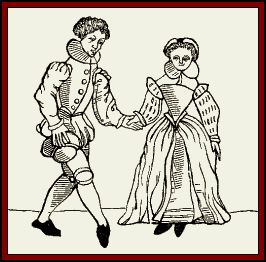The Marriage Ring

The modern engagement wedding set is unknown, although diamonds are popular. Mary Queen of Scots sent a diamond ring to Thomas duke of Norfolk as a symbol of her willingness to marry him. And Queen Elizabeth gave the duc d'Alencon a diamond ring with a pledge of her hand in marriage.
The ring goes on the third finger of the left hand (ring finger) as it does today. The common belief was that women have a vein in that finger that leads directly to the heart. Even people who know that can't be true believe it at weddings.
Margaret Audley, the duchess of Norfolk, is shown with a simple, if rather large, diamond on the third finger of her left hand.
In 1567, Elizabeth Polsted's wedding ring cost 4 shillings, which included 9d for extra gold.
Many marriage rings have mottoes inscribed on the inside or outside of the band, usually in French or Latin. These are usually brief:
Love True
Forever
With everlasting Love
Or they may be longer:
I am yours, love me truly.
After consent, ever content.
Love me and leave me not.
Some may be in Latin, for the loftier minded:
Maneat inviolata fides (Let your faith be inviolate)
Conjugii firmi et casti sum pignus amoris (I am the pledge of loyal marriage and chaste love.)
There are a few variations, including the interlocking gimmel or joint ring, rather like a puzzle ring. The gimmel consists of from 3 to 8 interlocking bands.
Some versions open to reveal a heart. Some have a motto on each band creating a little poem or poesy. These are also called poesy rings. For example:
Love is fix'd, I will not rangeor
I like my choice, I will not change
Wit, health, and beauty all do dwell
But constant Love doth far excel
The eye do findAnd so on�
The heart doth choose
And love doth bind
Till death doth loose
Among the poor, many wives may go their whole lives without a ring, due to the cost. (In a country village, everyone knows who is married.) In some families, the ring may be one that has been preserved and passed down.
However, wearing the espousal or marriage ring isn't either universal or sentimental. Many portraits show no ring at all, on men or women.
Although Vives and others praise the wedding ring as a symbol of the bonds of marriage, no one ever offers to explain why men don't wear them. Puritans disapprove of them as intolerable Romish superstition.
Scottish protestants don't use a ring in their ceremonies, and English Puritans resist it furiously. Widows put away their marriage rings since they are no longer considered to be married.
SourcesCressy: Birth, Marriage, & Death
Pearson: Elizabethans at Home
Kuntz: Rings for the Finger
![]() Weddings & Betrothals
Weddings & Betrothals
![]() Love & Marriage
Love & Marriage
![]() More Wedding Customs
More Wedding Customs





22 March 2008 pkm
